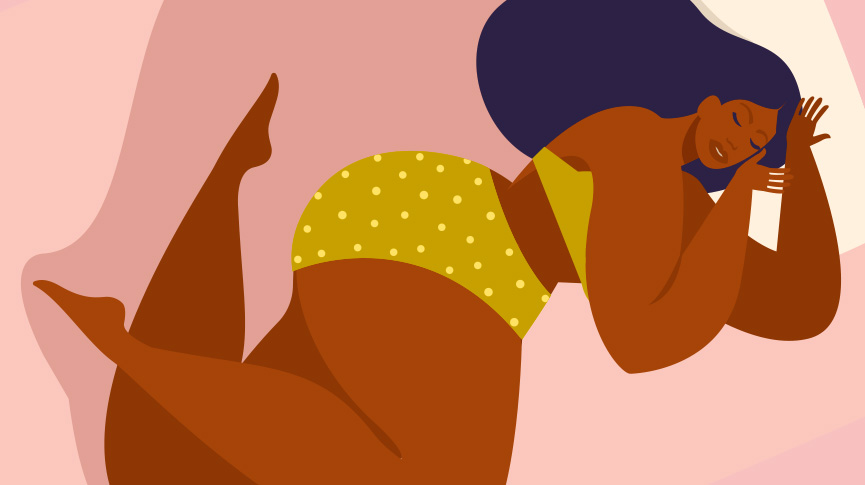4 Causes Of Severe Period Cramps

It’s a well-established fact that periods are a pain – literally. For some women, it’s a dull ache that can easily be taken care of with ibuprofen.
For a lot of women, it’s a little more severe, but nothing a painkiller and hot water bottle can’t handle. But for some of us, it makes us double over, unable to get out of bed, much less leave the house.
Many women assume that their menstrual pain is just part of the female experience, but there is absolutely no need to put up with pain, and suffering through it could actually be doing you more harm than good! Read on to learn more about menstrual pain and see if you are due a chat with your doctor.
Kinds of Period Pain
The medical term for menstrual cramps is dysmenorrhea, and there are actually two types. Primary dysmenorrhea is the name for “common” menstrual cramps, the ones that most of us get in our lower abdomen or back. They can be mild or more painful, and usually, start a little before or at the start of your period and continue for up to three days. They usually become less painful as you get older. There’s a relatively simple explanation for this kind of period pain, and it can be easy to manage. (Although it’s still not enjoyable!)
Secondary dysmenorrhea is much more painful, and a little more concerning because it’s caused by a disorder in your reproductive organs. If you think you might be experiencing this, make sure that you get checked by a doctor.
What’s Behind Severe Pain
There are a few reasons you could be experiencing intense menstrual pain.
Endometriosis – Endometriosis is a condition where the tissue that lines the inside of your uterus (the endometrium) is found outside of it, commonly on your ovaries or the tissue lining your pelvis, but sometimes it spreads beyond that. Severe, incapacitating pain before, during, or after your period, during sex or with bowel movements or urination are the most common symptom, but you may also experience heavy bleeding, fatigue and gastrointestinal distress.
Unfortunately, it often takes close to a decade before endometriosis is diagnosed since many women (and their physician) see their symptoms as normal menstrual symptoms or mistake it for another medical condition. Sadly, there is no definitive cure for endometriosis. Pregnancy or a hysterectomy sometimes helps alleviate the symptoms, but by no means always eradicates the disease. However, symptoms can be managed with pain-relievers or hormonal therapy.
Laparoscopic Surgery can be done to remove excess tissue, but it is also not a permanent solution and should be done as a last resort.
PCOS – Polycystic ovary or ovarian syndrome, commonly referred to as PCOS, occurs when out-of-balance levels of estrogen and progesterone lead to the growth of cysts on the ovaries. Common symptoms include irregular periods (which could mean having a prolonged period or less than 8 menstrual cycles in one year), excess facial and body hair or adult acne caused by excess male hormones and polycystic ovaries.
However, most women with these symptoms don’t seek medical attention until they have severe menstrual pain or difficulty getting pregnant. In fact, PCOS is one of the leading causes of female infertility.1 Unfortunately, there is no cure, but your doctor can help you manage your symptoms and provide treatment to help you get pregnant.
Fibroids – These are noncancerous growths in the uterus that usually appear during your childbearing years. They can vary in size and shape, and sometimes shrink or disappear on their own. It’s estimated that as many as 75% of us will have fibroids at some point, and we may not even know it because we don’t experience any physical effects.
Common symptoms include heavy or prolonged menstrual periods, frequent urination, constipation, and severe pain or backache. They’re also associated with pain during sex and difficulty emptying your bladder. There are many treatment options available, from implanting an IUD to minor surgery, so make sure you speak to your doctor.
Pelvic inflammatory disease (PID). We’re including this because although severe pain isn’t always a symptom, PID can be extremely dangerous or even life-threatening. An infection of the reproductive organs, PID can be caused by a number of different types of bacteria, including gonorrhea and Chlamydia. Symptoms include mild pain in the upper and lower abdomen, painful sex or urination, irregular menstruation, an increase in vaginal discharge, and fever. If you also experience severe and sharp pains, vomiting, a high fever, or fainting, see your doctor immediately.
Bottom line: if you are experiencing pain that is disrupting your life – see your doctor. Educate yourself about severe period pain, and make sure that are firm with them about your healthcare needs. Listen to your body, and don’t swallow your discomfort with ibuprofen in the name of being strong.
Taking control of your health is being a strong woman, so get informed and don’t suffer in silence.

A collective group of “lady experts” at Intimina who love sharing our personal experiences, even when they are a little too personal. We believe it’s time to start breaking down the taboos around menstruation, motherhood, and menopause, and start owning our female health.


